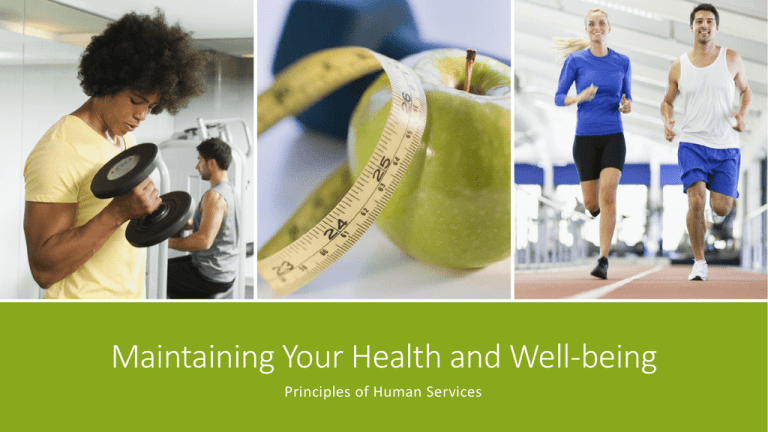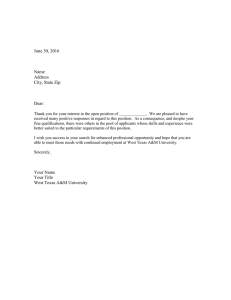
Maintaining Your Health and Well-being
Principles of Human Services
COPYRIGHT
Copyright © Texas Education Agency, 2014. These Materials are copyrighted © and trademarked ™ as the property of the Texas Education
Agency (TEA) and may not be reproduced without the express written permission of TEA, except under the following conditions:
1) Texas public school districts, charter schools, and Education Service Centers may reproduce and use copies of the Materials and Related
Materials for the districts’ and schools’ educational use without obtaining permission from TEA.
2) Residents of the state of Texas may reproduce and use copies of the Materials and Related Materials for individual personal use only,
without obtaining written permission of TEA.
3) Any portion reproduced must be reproduced in its entirety and remain unedited, unaltered and unchanged in any way.
4) No monetary charge can be made for the reproduced materials or any document containing them; however, a reasonable charge to cover
only the cost of reproduction and distribution may be charged.
Private entities or persons located in Texas that are not Texas public school districts, Texas Education Service Centers, or Texas charter schools
or any entity, whether public or private, educational or non-educational, located outside the state of Texas MUST obtain written approval
from TEA and will be required to enter into a license agreement that may involve the payment of a licensing fee or a royalty.
For information contact: Office of Copyrights, Trademarks, License Agreements, and Royalties, Texas Education Agency, 1701 N. Congress
Ave., Austin, TX 78701-1494; phone 512-463-7004; email: copyrights@tea.state.tx.us.
Copyright © Texas Education Agency, 2014. All rights reserved.
2
What are some indicators of well-being?
Copyright © Texas Education Agency, 2014. All rights reserved.
3
INDICATORS OF WELL-BEING
Adequate health
care
Strong family
structure
Secure parental
employment
Proper and
acceptable
behavior
Education
Well-Being
Food security
Physical
environment and
safety
Source: America’s Children in Brief: Key National Indicators of Well-Being, 2012
Copyright © Texas Education Agency, 2014. All rights reserved.
4
Adequate Health Care
Copyright © Texas Education Agency, 2014. All rights reserved.
5
PHYSICAL HEALTH
Taking care of your health is of the utmost importance to well-being
• Control weight
• Don’t abuse alcohol or other drugs
• Eat healthy foods
• Exercise regularly
• Get plenty of rest
• Stop smoking
Copyright © Texas Education Agency, 2014. All rights reserved.
6
APPLICATIONS FOR HEALTH
▪ Classes and trainers
▪ Cyclists
▪ Eating healthy
▪ Fitness
▪ Health
▪ Interval timers
▪ Meditation and mindfulness
▪ Runners
▪ Sleeping better
▪ Staying on track
▪ Stress relievers
▪ Weight loss programs
(click on picture)
Copyright © Texas Education Agency, 2014. All rights reserved.
7
Education
Copyright © Texas Education Agency, 2014. All rights reserved.
8
BENEFITS OF HIGHER EDUCATION
According to the College Board, there are many benefits to a higher education such as:
• Earnings
• Health benefits
• Health insurance
• Individual and societal benefits
• Job satisfaction
• Pension plans
• Social mobility
Food Security
Copyright © Texas Education Agency, 2014. All rights reserved.
10
FOOD SECURITY STATUS OF U.S. HOUSEHOLDS
WITH CHILDREN IN 2013
Source: United States Department of Agriculture
Copyright © Texas Education Agency, 2014. All rights reserved.
11
FOOD INSECURITY
Hunger exists everywhere in America – in
rural and urban communities and in every
county. In fact, the USDA reports that one in
six Americans faces hunger, including 16
million children.
Copyright © Texas Education Agency, 2014. All rights reserved.
12
FOOD SECURITY VERSUS FOOD INSECURITY
Copyright © Texas Education Agency, 2014. All rights reserved.
13
EFFECTS OF GOOD NUTRITION
▪ Appearance
▪ Fitness
▪ Emotional strength
▪ Future health
▪ Healing
▪ Protection from illness
▪ Weight
Copyright © Texas Education Agency, 2014. All rights reserved.
14
NUTRIENTS
Nutrients keep our body healthy. They Include:
▪ Carbohydrates
▪ Fats
▪ Fat-soluble vitamins
▪ Minerals
▪ Proteins
▪ Vitamins
▪ Water
▪ Water-soluble vitamins
Copyright © Texas Education Agency, 2014. All rights reserved.
15
CHOOSEMYPLATE
(click on picture)
(click on picture)
Copyright © Texas Education Agency, 2014. All rights reserved.
16
Physical Environment and Safety
Copyright © Texas Education Agency, 2014. All rights reserved.
17
ENVIRONMENT AND SAFETY
The environment in which children live
plays an important role in their health
and development.
▪ Children may be more vulnerable than
adults to the adverse effects of
environmental contaminants in the air,
food, drinking water and other sources
because their bodies are still
developing.
▪ Violence has a long-lasting effect on
individuals.
▪ Unintentional injuries may result in
death for children.
Proper and Acceptable Behavior
Copyright © Texas Education Agency, 2014. All rights reserved.
19
PROPER AND ACCEPTABLE BEHAVIORS
Individuals should avoid participating in:
▪ Alcohol use
▪ Criminal activity
▪ Illicit drug use
▪ Regular use of tobacco
▪ Risky sexual activity
(click on picture)
Secure Parental Employment
Copyright © Texas Education Agency, 2014. All rights reserved.
21
What is a workplace health program, and how can
employers benefit from this program? Employees?
Copyright © Texas Education Agency, 2014. All rights reserved.
22
OVERVIEW OF POTENTIAL BENEFITS OF
WORKPLACE HEALTH PROGRAMS TO EMPLOYERS
The benefits for employers include:
• Decreased rates of illness and injuries
• Enhanced corporate image
• Enhanced employee productivity
• Improved employee morale
• Improved employee recruitment and retention
• Increased organizational commitment and creation of a culture of health
• Lower health care and disability costs
• Reduced employee absenteeism
Copyright © Texas Education Agency, 2014. All rights reserved.
23
OVERVIEW OF POTENTIAL BENEFITS OF
WORKPLACE HEALTH PROGRAMS TO EMPLOYEES
The benefits for employees include:
▪ Improved coping skills with stress or other factors affecting health
▪ Improved health status
▪ Improved job satisfaction
▪ Increased access to health promotion resources and social support
▪ Increased well-being, self-image and self-esteem
▪ Lower costs for acute health issues
▪ Lower out-of-pocket costs for health care services
▪ Safer and more supportive work environment
Copyright © Texas Education Agency, 2014. All rights reserved.
24
Strong Family Structure
Copyright © Texas Education Agency, 2014. All rights reserved.
25
ROLES AND RESPONSIBILITIES OF FAMILY MEMBERS
Individuals within the family provide the following:
▪ Basic needs (such as food, clothing and shelter)
▪ Economic support
▪ Education
▪ Love and affection
▪ Nurturance
▪ Opportunities to have fun
▪ Protection
▪ Religious background
Copyright © Texas Education Agency, 2014. All Rights Reserved.
26
BENEFITS OF A FAMILY
Maslow’s Hierarchy of Needs
Provides for physical needs
(food, shelter, clothing,
protection and security)
Satisfies one’s emotional
needs (encouragement,
support, belonging,
companionship, love, selfesteem and selfactualization)
Copyright © Texas Education Agency, 2014. All Rights Reserved.
27
PREPARING FOR THE NEXT DECADE: A 2020 VISION FOR HEALTHY PEOPLE
(click on picture)
Copyright © Texas Education Agency, 2014. All rights reserved.
28
What are examples of generally unhealthy lifestyles?
Copyright © Texas Education Agency, 2014. All rights reserved.
29
ADVERSE EXPERIENCES
Nearly one in eight children (12 percent) has had three or more negative life experiences
associated with levels of stress that can harm his or her health and development.
These experiences may include:
▪ abuse or neglect
▪ chronic economic hardship
▪ living with someone who has a mental illness or substance abuse problem
▪ parental divorce or separation
▪ social exclusion by peers
▪ the death of a parent
▪ witnessing domestic violence
Copyright © Texas Education Agency, 2014. All rights reserved.
30
What is stress, and what are some effects of stress
associated in each area?
Body
Mind
Stress
Behavior
Emotions
Copyright © Texas Education Agency, 2014. All rights reserved.
31
THE EFFECTS OF STRESS
•
•
•
•
Fatigue
Headaches
Skin irritations
Tight muscles
Body
Mind
•
•
•
•
Impaired judgment
Indecisiveness
Negativity
Worrying
•
•
•
•
Apathy
Apprehension
Depression
Loss of confidence
Stress
• Accident prone
• Excessive drinking or
use of illegal drugs
• Loss of appetite
• Restlessness
Behavior
Emotions
Copyright © Texas Education Agency, 2014. All rights reserved.
32
WAYS TO COPE WITH STRESS AND DEPRESSION
Mental health resources include:
• Community mental health centers
• Employee assistance programs
• Mental health programs at universities
or medical schools
• Family services, social agencies, or
clergy
• Mental health specialists, such as
psychiatrists, psychologists, social
workers or mental health counselors
• Health maintenance organizations
• Peer support groups
• Hospital psychiatry departments and
outpatient clinics
• Private clinics and facilities
• Local medical and/or psychiatric
societies
• State hospital outpatient clinics
Copyright © Texas Education Agency, 2014. All rights reserved.
33
HOW TO CONSTRUCT A DIORAMA
(click on picture)
Copyright © Texas Education Agency, 2014. All rights reserved.
34
QUESTIONS?
Copyright © Texas Education Agency, 2014. All rights reserved.
35
REFERENCES AND RESOURCES
Images:
▪
Microsoft Clip Art: Used with permission from Microsoft™.
Textbooks:
▪
Ryder, V., & Harter, M. B. (2010). Contemporary living. Tinley Park, IL: Goodheart-Willcox
Websites:
▪
Centers for Disease Control and Prevention
Benefits of Health Promotion Programs.
http://www.cdc.gov/workplacehealthpromotion/businesscase/benefits
▪
Centers for Disease Control and Prevention
The early years of a child’s life are very important for his or her health and development.
http://www.cdc.gov/ncbddd/childdevelopment/index.html
▪
Childstats.gov
America’s Children in Brief: Key National Indicators of Well-Being, 2012.
http://www.childstats.gov/pdf/ac2012/ac_12.pdf
▪
College Board
Education Pays 2013: The Benefits of Higher Education for Individuals and Society.
http://trends.collegeboard.org/sites/default/files/education-pays-2013-full-report.pdf
▪
Healthy.gov
Home of the Office of Disease Prevention and Health Promotion.
http://health.gov/our-work/healthy-people
Copyright © Texas Education Agency, 2014. All rights reserved.
36
REFERENCES AND RESOURCES
▪
MyPlate.gov
MyPlate, the government’s newest symbol for healthy eating, uses a dinner plate icon as a simple visual reminder of what to serve yourself, and your family for meals and at snack time.
http://wwwchoosemyplate.gov
▪
National Dairy Council
The Dairy Connection.
http://www.nationaldairycouncil.org/HealthandWellness/FutureofFood/Pages/Future-of-Food.aspx
▪
United States Department of Agriculture
Food security status of United States households with children in 2013.
http://www.ers.usda.gov/topics/food-nutrition-assistance/food-security-in-the-us/key-statistics-graphics.aspx#children
▪
U.S. Department of Health and Human Services
Health topics to help you and your loved ones stay healthy.
http://healthfinder.gov/Default.aspx
Technology:
▪
How to Make a Four-Door Diorama
http://snapguide.com/guides/make-a-four-door-diorama
▪
Introducing the New Food Icon: MyPlate
The Department of Agriculture introduces the new food icon, MyPlate, to replace the MyPyramid image as the government’s primary food group symbol. An easy-to-understand visual cue to help consumers
adopt healthy eating habits, MyPlate is consistent with the 2010 Dietary Guidelines for Americans.
http://youtu.be/SEFmSk08LIE
▪
National Institute on Drug Abuse (NIDA)
Anyone Can Become Addicted to Drugs - You might think that only some types of people can get addicted to drugs. The truth is, it can happen to anyone, whether young or old, rich or poor, male or female.
This video from NIDA explains addiction in simple terms and offers a hotline to help you or a loved one find treatment.
http://youtu.be/SY2luGTX7Dk
▪
Preparing for the Next Decade: A 2020 Vision for Healthy People
Healthy People provides science-based, 10-year national objectives for improving the health of all Americans. Featuring Assistant Secretary for Health, Dr. Howard Koh, this presentation demonstrates how
public health professionals and educators should use Healthy People.
http://youtu.be/zZG94c7xQmE
Copyright © Texas Education Agency, 2014. All rights reserved.
37

